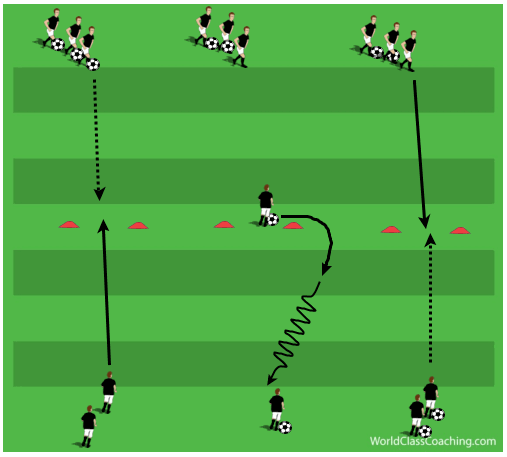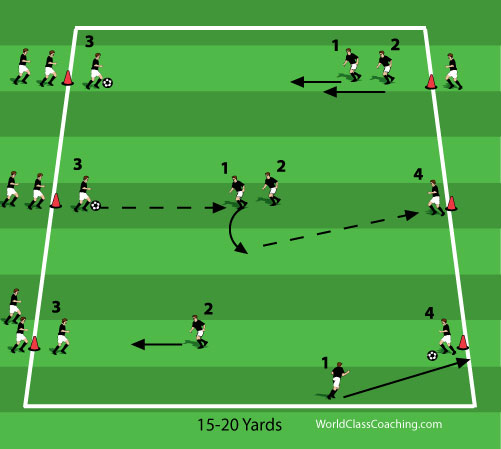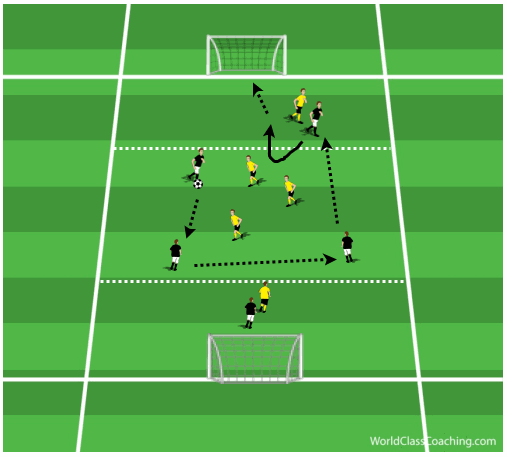Podcast: Play in new window | Download
Subscribe: Apple Podcasts | RSS
In this episode I share a session on turning. This is obviously an important skill for players at every position. Turning away from pressure and into space is one of the foundational skills required to possess the ball. Turning the ball with control also works on the first touch since you have to have a plan for where the ball will go and how you will get it there. It’s very important that the players know where the pressure is so awareness is a key element of turning successfully. Since you have to have good service to practice turning, passing technique is central to the success of the practice.
This is a progressive session so it gradually adds pressure and complexity and ends by applying the skills in game situations. This progression helps to create a transfer of training from the basic practice to a game.
I think you’ll find this session useful for teams of any age or experience level.
Featured Training Session
SetUp
Two lines of players. There’s a cone gate in between them. One player starts with a ball. The player across from him shows into the gate. Timing their run to go through the gate as the ball arrives. The passer needs to be sure to let the receiver get through the gate before they have to take their first touch.
The receiver then turns around the outside or through the middle depending on the type of turn they are using. After turning the ball is passed to the first player in the line they came from. With younger players you might have each player have their own ball so that the exercise moves more quickly.
Types of Turns
Opening the Gate
- Step toward the ball so that the ball rolls across your body
- Receive it with the inside of your back foot
- Play away with the outside of the same foot through the gate
Inside of the Foot
- Use the inside of the foot that the ball comes to
- Control it across your body
- Taking it early, out in front of you, will allow you to turn around the cone with one touch
Outside of the Foot
- Use the outside of the OPPOSITE foot
- This means that you have to reach across your body
- Control the ball across your body
- Again, taking it early will help you to turn in one touch
- This one is challenging at first so have the players take a little off their passes to give the receiver more time to react
(Good, isn’t she!)
Cruyff
- Use the inside of the foot that the ball comes to
- Control it behind your standing leg
- Diagonally through the gate
- Have the receiver show to one cone or the other to create an angle
- This also helps with the outside of the foot turn
- There are other turns but these are the four core movements that I teach
This begins as a pattern exercise to focus on the technique of turning and we gradually add pressure.
- Basic Pattern
- Two lines of players are facing each other
- One player has a ball (Player 3)
- A player from the opposite line starts in the middle (Player 1)
- Player 1 goes back toward his line and tags the next player (Player 2)
- Player 1 then checks back toward the ball and Player 3
- Player 2 follows closely behind
- Player 1 calls for the ball and Player 3 passes it to him
- Player 1 receives the ball and turns around Player 2 using one of the four turns taught earlier
- Player 2 then moves to tag Player 3 while Player 1 passes to Player 4 and the pattern continues
Coaching Points
- Make sure the passer is ready before checking to the ball
- Hold your run if necessary
- Check away quickly from Player 2
- Check your shoulder to see if Player 2 is following
- Call for the ball early so you have space to receive the ball
- Check your shoulder again after calling for the ball to see the position of the defender
- Turn the ball across your body and away from the defender
- Always demand a quality of the pass
Progressions
- Apply physical pressure by having the defender put one had on the attackers shoulder
- This also provides a clue as to which side to turn away from
- Have the defender pick a side so that they attacker can turn to the open side but do not put a hand on their shoulder so they have to look for the defender
- Allow the defender to tackle if the attacker turns into them
- Allow full pressure from the defender
I like to incorporate shooting into training sessions whenever possible
- Fun for the players
- Shows them how the skill can create goalscoring opportunities
- Helps with transfer of training
Setup
- Line of players with a ball each next to each goal (diagonal from each other)
- A flag (or cone) 15 yards in front of the line and outside of the penalty area
- This will be different for different age groups but that’s the point
Pattern
- The first player in line starts without a ball and jogs to the flag and then checks back to receive a pass
- Use a turn and shoot on goal
- The shooter can become the keeper and the keeper gets a ball and joins the end of the line next to that goal
- Have the lines switch to the other side of the goal to work on turning both ways
Progression
- Put a player in place of the flag or cone
- The players rotate from passer to receiver to defender and then the goalkeeper
- Start with shadow defender and progress to full pressure
Now we’re moving toward applying these skills to game situations
Set-Up
- There are three zones
- In the example we play 3 v 3 in the middle
- Each team has a forward in front of the goal they are attacking as well as a defender protecting their goal
- These are the only players allowed outside of the middle zone
- You can scale this up depending on the number of players you have at training
- The middle players attempt to complete three passes before playing to their attacker
- The attacker attempts to turn and finish
- Rotate your attacker, defenders and midfielder if you would like or put them in their usually positions depending on the age group you are working with
Coaching Points
- To start with, the defend must stay behind the attacker until they have their first touch
- Encourage the attacker to ‘stay high’ up the field, away from the middle zone
- This creates space for them to show into and room to turn
- If they get too close too early the defender will be right on top of them when they receive the ball
Progression
- Have one defensive midfielder recover to encourage the attacker to turn quickly and score
- Have one attacking midfielder join the attacker in support
- Add a second attacker and defender to the final third to work on the attackers movements and combinations between them
Finish with free play
This allows you to see if what you’ve taught has been understood and can be applied without artificial rules.
Don’t Forget!
Make sure you subscribe to Coaching Soccer Weekly through iTunes, or your podcast provider of choice, to be sure you never miss an episode.
We would appreciate it if you would leave us a 5 star rating and/or a written review on iTunes to help spread the word about the show and ensure that we can continue to bring you top notch guests in the future.
In the Next Episode
I talk about my favorite format for training creative goalscorers. Technical shooting work is necessary but it’s exercises like this that help you transfer that skill training to the game.
Future Interviews
In an upcoming episode we talk to Wayne Harrison about training soccer awareness. Wayne has coached at every level of the game and I know you’ll enjoy his insights.





Absolutely loved this session!!
So, much so, you’ve inspired me to write a post on how to turn effectively in the short-sided game – http://fiveasidefootballcoach.com/turn-marker/
Thanks a lot and keep up the good work!
That’s great! Thanks for sharing.